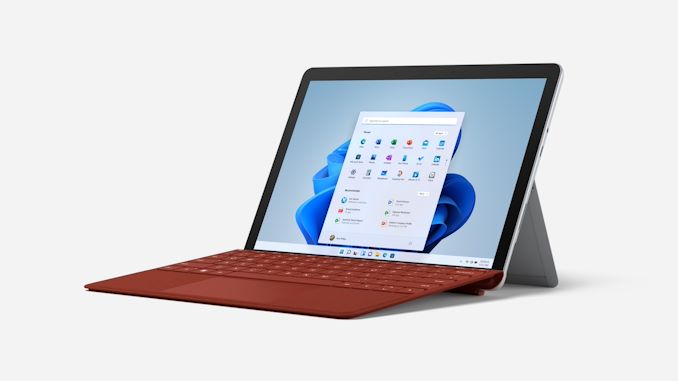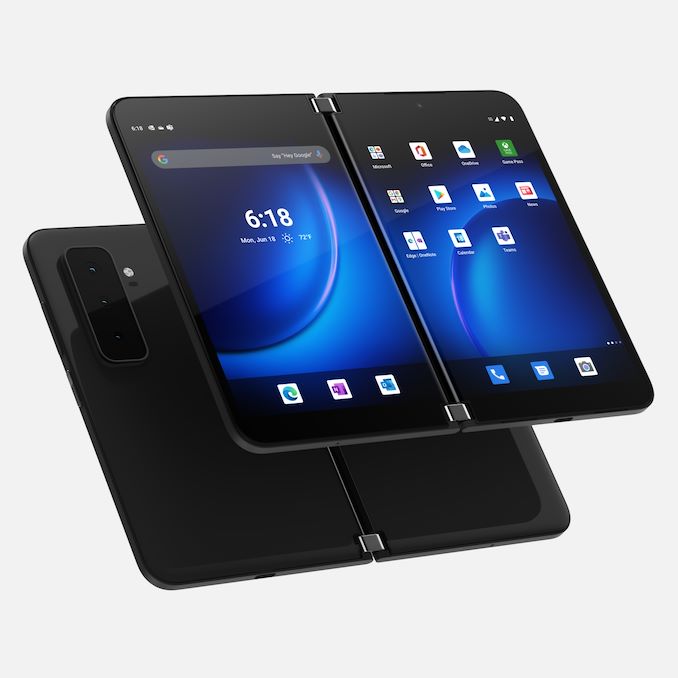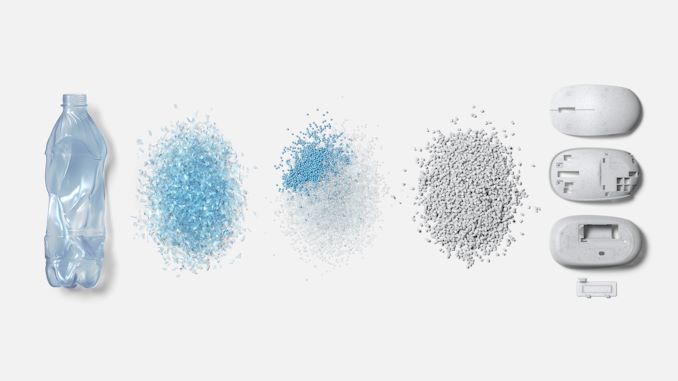Surface Laptop Studio, Surface 8 Pro Lead Microsoft's New Surface 2021 Lineup
by Brett Howse on September 22, 2021 12:00 PM ESTSurface Go 3
There is a small bump for the Surface Go line, going from version 2 to version 3. The Surface Go is the smallest, lightest, and least expensive Surface device in the lineup, but has suffered from anemic performance compared to the rest of the devices. The only significant change to the Surface Go 3 is that there is now an optional Core i3-10100Y processor, which is a higher speed bin of the venerable Amber Lake-Y dual core SoC that Microsoft used in the Surface Go 2. The base offering still comes with a Pentium dual-core, though the Pentium Gold 6500Y used here is a big step up in some ways since it can turbo to 3.4GHz, whereas the Go 2's Pentium 4425Y lacked turbo altogether.
Meanwhile the base model still ships with just 64 GB of eMMC storage, although 128 and 256 GB SSDs are available, with the latter being only on the commercial lineup. Luckily the price didn’t change, with the Surface Go 3 still starting at just $400, although that model with 4 GB of RAM and 64 GB of eMMC storage would feel awfully slow for most people.
Surface Duo 2
The second-generation Microsoft-designed folding phone is also being announced and adds performance and usability to help it compete in the high-end of the mobile phone space. Now shipping with the Qualcomm Snapdragon 888 SoC, the Surface Duo 2 adds a lot to its camera department with the inclusion of a triple-camera for wide, ultra-wide, and telephoto photos.
The folding display also gets a size bump from 5.6-inch individual screens to 5.8-inch panels, which provides an effective display size of 8.3-inches when both are opened. The Surface team also took the opportunity to add 5G support, which is also expected in 2021.
For multi-tasking, there is 8 GB of LPDDR5 memory, and storage options are 128 GB, 256 GB, or 512 GB.
The Surface Duo 2 is really supposed to showcase Microsoft’s Android app suite for Office, and with the updates, it should do a much better job considering the high-entry price of $1500.
Accessories
In addition to the devices, Microsoft is also releasing a couple of new accessories. The Microsoft Ocean Plastic Mouse is made from 20% recycled ocean plastic and is just $25.
The Surface Adaptive Kit, designed in partnership with people with disabilities, is a set of textured labels which can be attached to the keyboard and ports to make it easier to identify what they are by touch and color.
Summary
Microsoft’s Surface team has grown from just designing a couple of devices, to a wide swath of devices covering a large part of the PC market, and they have expanded beyond those borders too with the Surface Duo and Surface Duo 2. Looking at the devices holistically, the design team generally tries to offer something with a slight twist compared to the other designs on the market, and some are more successful design wins than others. The Surface Pro, as an example, as created an entire genre of devices that mimic it, and the update being announced today is a solid refresh of that design which should allow Surface Pro to continue to be the industry leader.
The Surface Laptop Studio is an interesting design, and while not a completely new concept, it looks to be a well-executed take on the convertible laptop. From the specifications, it appears to be taking over from the Surface Book, which was their previous performance-laptop. It is less complicated than the Surface Book, which should lead to an overall better product.
The Surface Pro X certainly did not see very much love, and Windows on Arm did not get advanced at all on the hardware front today. The Surface Pro 8 now gets the same 13-inch display, which is good for the Pro 8, but does diminish the Pro X. Surface Go 3 also got just the tiniest of updates and is still a somewhat awkward device. The base model is inexpensive, but unimpressive, and when the necessary options are chosen, the price creeps up. It is still a well-built device, with a wonderful magnesium allow chassis and individually calibrated display, which sounds great for $400, but the $400 model is significantly more disappointing than the upgraded models sadly.
Microsoft tends to update their hardware at almost random intervals, but quibbles aside, these updates are all welcome, with some really excellent changes, such as the addition of Thunderbolt 4. I look forward to being able to try some of these devices out in the future and see how much the changes impact the device experience.
















113 Comments
View All Comments
lmcd - Friday, September 24, 2021 - link
You're kidding yourself if you really think consumers aren't interested in docks at home in today's WFH environmentm1013828 - Thursday, September 23, 2021 - link
Id love to see a Ryzen surface pro.Hell, Call it the Surface pro Type R! make it a little fatter with more heatsink to allow 25w power budget as a point of difference to allow the ryzen and its GPU to fly.
brantron - Thursday, September 23, 2021 - link
The current Surface Pro 7+ already runs in 28 watt mode, yet the fanless i5 doesn't even warm up. I have mine set to idle at the 2.4 GHz base clock because it's overzealous about trying to shave off a fraction of 1 watt while it's barely above room temperature....which raises further questions about the obese Laptop Studio stuck with the same CPU.
DigitalFreak - Thursday, September 23, 2021 - link
Microsoft is always a hardware cycle behind everyone else.ChrisGX - Friday, September 24, 2021 - link
High end Tiger Lake parts are fast and relatively energy efficient. Alder Lake is another Intel part not a revelation. At 35W TDP or below Tiger Lake is a sensibly specced CPU for the Surface Laptop Studio. The upgrade over what other run-of-the-mill Surface devices offer is the GPU and making allowance for a powerful GPU makes very good sense on this new product (just as it did on the Surface Book and the Surface Studio).The Surface Book is a great product with many of the virtues of the Surface Laptop Studio in a detachable configuration that arguably would satisfy the needs of many users better than this new tablety laptop. I don't know the answer to your question but it would be a miserable thing to cut short the life of the Surface Book for the sake of the Surface Laptop Studio.
MrCommunistGen - Wednesday, September 22, 2021 - link
Microsoft probably can't make Qualcomm to build a better SoC (or at least doesn't want to spend the money to force the issue), but the SQ1/SQ2 are getting a bit long in the tooth.I'd really love to see what the latest and greatest generation ARM cores bring to the table for Windows on ARM performance.
Maybe Microsoft can go the Google route and build their own ARM SoC or commission someone other than Qualcomm to build something that's actually modern at time of release.
DigitalFreak - Thursday, September 23, 2021 - link
An extremely low number of people want a Windows device that has to run Windows apps through emulation. They've tried to push them over and over again.ChrisGX - Friday, September 24, 2021 - link
All critical applications will be built for ARM in time and higher performance ARM chips are coming - the NUVIA/Qualcomm SoC should be pretty good. No one is being forced to run Windows apps in emulation. Early Windows on ARM adopters (and everything is still at an early stage) will primarily be interested in the low power draw and energy efficiency of ARM parts which will be great for tablets and fanless laptops. If anyone needs to run x86 application binaries on ARM and they don't like the performance they won't be buying ARM but that won't stop the progress of WoA. None of this will be happening overnight. (For the record, x86 applications already run well on ARM, namely x86 Mac applications on the Apple M1 SoC, but that is no help to Windows users, unfortunately.)MakaanPL - Wednesday, September 22, 2021 - link
According to Microsoft website, Surface Pro 8 supports Dolby Vision as well, it's not only for Laptop Studio. This probably means the display will eventually go beyond sRGB.lemurbutton - Wednesday, September 22, 2021 - link
None of these are competitive with the M1 Macbooks and the upcoming M2X (A15 based) Macbook Pros slated for release later this year.